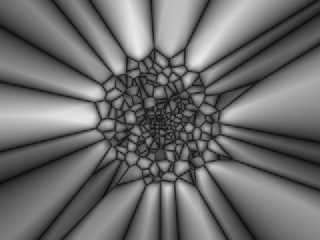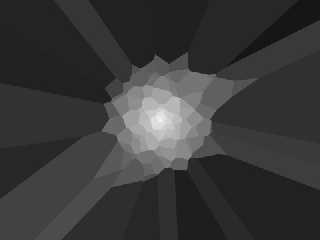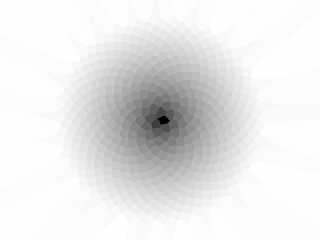 |
 |
|
 |
|
 |
|  |
|  |
|
 |
|
 |
|  |
|  |
|
 |
Here's a little patch I've been working on. It is very similar to the
crackle pattern, but rather than using a 3D grid of points that is
randomly jittered, it uses a user-specified set of points. It is
actually very fast, usually faster than the crackle pattern. It stores
the points in a binary space partition tree, which it can then search
very quickly, while the crackle pattern must always check a large number
of points, and sometimes recompute all of them. The options available
are the same as for the crackle pattern, with the addition of the
points. You can specify the points alone, or with a blend map index for
each point, giving you an effect similar to the "solid" feature, but
with much more control.
--
Christopher James Huff <cja### [at] earthlink net>
http://home.earthlink.net/~cjameshuff/
POV-Ray TAG: <chr### [at] tag net>
http://home.earthlink.net/~cjameshuff/
POV-Ray TAG: <chr### [at] tag povray povray org>
http://tag.povray.org/ org>
http://tag.povray.org/
Post a reply to this message
Attachments:
Download 'voronoi1.jpg' (32 KB)
Download 'voronoi2.jpg' (12 KB)
Download 'voronoi3.jpg' (13 KB)
Preview of image 'voronoi1.jpg'

Preview of image 'voronoi2.jpg'

Preview of image 'voronoi3.jpg'

|
 |
|  |
|  |
|
 |
|
 |
|  |
|  |
|
 |
Nice one, Chris! Source! Source! :)
How is a Voronoi Diagram/Delunay triangulation generated from a BSP tree?
George
On Thu, 25 Dec 2003 19:57:59 -0500, Christopher James Huff
<cja### [at] earthlink net> wrote:
> Here's a little patch I've been working on. It is very similar to the
> crackle pattern, but rather than using a 3D grid of points that is
> randomly jittered, it uses a user-specified set of points. It is
> actually very fast, usually faster than the crackle pattern. It stores
> the points in a binary space partition tree, which it can then search
> very quickly, while the crackle pattern must always check a large number
> of points, and sometimes recompute all of them. The options available
> are the same as for the crackle pattern, with the addition of the
> points. You can specify the points alone, or with a blend map index for
> each point, giving you an effect similar to the "solid" feature, but
> with much more control.
>
>
>
--
Using M2, Opera's revolutionary e-mail client: http://www.opera.com/m2/ net> wrote:
> Here's a little patch I've been working on. It is very similar to the
> crackle pattern, but rather than using a 3D grid of points that is
> randomly jittered, it uses a user-specified set of points. It is
> actually very fast, usually faster than the crackle pattern. It stores
> the points in a binary space partition tree, which it can then search
> very quickly, while the crackle pattern must always check a large number
> of points, and sometimes recompute all of them. The options available
> are the same as for the crackle pattern, with the addition of the
> points. You can specify the points alone, or with a blend map index for
> each point, giving you an effect similar to the "solid" feature, but
> with much more control.
>
>
>
--
Using M2, Opera's revolutionary e-mail client: http://www.opera.com/m2/
Post a reply to this message
|
 |
|  |
|  |
|
 |
|
 |
|  |
|  |
|
 |
Seems like this is something that is not yet supported in the official 3.5,
correct?
Very nice work.
Dennis
"Christopher James Huff" <cja### [at] earthlink net> wrote in message
news:cja### [at] netplex net> wrote in message
news:cja### [at] netplex aussie aussie org...
> Here's a little patch I've been working on. It is very similar to the
> crackle pattern, but rather than using a 3D grid of points that is
> randomly jittered, it uses a user-specified set of points. It is
> actually very fast, usually faster than the crackle pattern. It stores
> the points in a binary space partition tree, which it can then search
> very quickly, while the crackle pattern must always check a large number
> of points, and sometimes recompute all of them. The options available
> are the same as for the crackle pattern, with the addition of the
> points. You can specify the points alone, or with a blend map index for
> each point, giving you an effect similar to the "solid" feature, but
> with much more control.
>
>
>
> --
> Christopher James Huff <cja### [at] earthlink org...
> Here's a little patch I've been working on. It is very similar to the
> crackle pattern, but rather than using a 3D grid of points that is
> randomly jittered, it uses a user-specified set of points. It is
> actually very fast, usually faster than the crackle pattern. It stores
> the points in a binary space partition tree, which it can then search
> very quickly, while the crackle pattern must always check a large number
> of points, and sometimes recompute all of them. The options available
> are the same as for the crackle pattern, with the addition of the
> points. You can specify the points alone, or with a blend map index for
> each point, giving you an effect similar to the "solid" feature, but
> with much more control.
>
>
>
> --
> Christopher James Huff <cja### [at] earthlink net>
> http://home.earthlink.net/~cjameshuff/
> POV-Ray TAG: <chr### [at] tag net>
> http://home.earthlink.net/~cjameshuff/
> POV-Ray TAG: <chr### [at] tag povray povray org>
> http://tag.povray.org/
>
> org>
> http://tag.povray.org/
>
>
Post a reply to this message
|
 |
|  |
|  |
|
 |
|
 |
|  |
|  |
|
 |
In article <opr0roznhnhr234r@news.povray.org>,
George Pantazopoulos <george@gamma*KILLSPAM*burst.net> wrote:
> How is a Voronoi Diagram/Delunay triangulation generated from a BSP tree?
The same way the crackle pattern does it. The distances of the three
nearest points are found, and the pattern value is computed from that.
The voronoi pattern just stores user-defined points in a quickly
searchable tree structure, rather than generating pseudo-random points
(stored in a cache array) on the fly.
Post a reply to this message
|
 |
|  |
|  |
|
 |
|
 |
|  |
|  |
|
 |
In article <3feba466$1@news.povray.org>,
"Dennis Miller" <dhm### [at] comcast net> wrote:
> Seems like this is something that is not yet supported in the official 3.5,
> correct?
Correct, this is a patch I created. net> wrote:
> Seems like this is something that is not yet supported in the official 3.5,
> correct?
Correct, this is a patch I created.
Post a reply to this message
|
 |
|  |
|  |
|
 |
From: Jim Charter
Subject: Re: Voronoi pattern - attached files (1/1)
Date: 26 Dec 2003 00:33:34
Message: <3febc82e@news.povray.org>
|
|
 |
|  |
|  |
|
 |
Looks very exciting. What are the options for specifyimg points? Could
the vertices of a mesh be used for instance?
Post a reply to this message
|
 |
|  |
|  |
|
 |
|
 |
|  |
|  |
|
 |
> rather than using a 3D grid of points that is
> randomly jittered, it uses a user-specified set of points.
Can they be 4D? =)
- Slime
[ http://www.slimeland.com/ ]
Post a reply to this message
|
 |
|  |
|  |
|
 |
|
 |
|  |
|  |
|
 |
In article <3febe5bb$1@news.povray.org>, "Slime" <fak### [at] email address>
wrote:
> > rather than using a 3D grid of points that is
> > randomly jittered, it uses a user-specified set of points.
>
> Can they be 4D? =)
It would actually be pretty easy to do, and it's a feature I've been
looking at implementing. In a way, they are already...the offset feature
specifies the distance along the fourth dimension of all the points. You
just can't have variation in that direction.
Anyway, I do plan on trying it out, as part of some extensions to the
BSP code to more optimally handle the 2D and 1D cases (where all points
are in a axis-aligned plane or aligned along a line).
I'd also like to implement a 4D noise pattern, which is something I've
seen used for things like flames... address>
wrote:
> > rather than using a 3D grid of points that is
> > randomly jittered, it uses a user-specified set of points.
>
> Can they be 4D? =)
It would actually be pretty easy to do, and it's a feature I've been
looking at implementing. In a way, they are already...the offset feature
specifies the distance along the fourth dimension of all the points. You
just can't have variation in that direction.
Anyway, I do plan on trying it out, as part of some extensions to the
BSP code to more optimally handle the 2D and 1D cases (where all points
are in a axis-aligned plane or aligned along a line).
I'd also like to implement a 4D noise pattern, which is something I've
seen used for things like flames...
Post a reply to this message
|
 |
|  |
|  |
|
 |
|
 |
|  |
|  |
|
 |
In article <3febc82e@news.povray.org>, Jim Charter <jrc### [at] msn com>
wrote:
> Looks very exciting. What are the options for specifyimg points? Could
> the vertices of a mesh be used for instance?
You either specify point vectors or float-vector pairs. If the latter,
the result is similar to crackle with the solid feature turned on,
except that it uses the specified value for that cell rather than a
pseudo-random one. The points can be whatever you want...mesh vertices
would work, but you would have to extract the actual vertex locations.
voronoi {
offset FLOAT
form FLOAT
metric FLOAT (actually a vector, but only the x component is used)
POINTS
}
POINTS:
VECTOR,
VECTOR,
VECTOR...
or:
[FLOAT VECTOR]
[FLOAT VECTOR]
[FLOAT VECTOR]
You must specify at least 3 points, but that is the only restriction. com>
wrote:
> Looks very exciting. What are the options for specifyimg points? Could
> the vertices of a mesh be used for instance?
You either specify point vectors or float-vector pairs. If the latter,
the result is similar to crackle with the solid feature turned on,
except that it uses the specified value for that cell rather than a
pseudo-random one. The points can be whatever you want...mesh vertices
would work, but you would have to extract the actual vertex locations.
voronoi {
offset FLOAT
form FLOAT
metric FLOAT (actually a vector, but only the x component is used)
POINTS
}
POINTS:
VECTOR,
VECTOR,
VECTOR...
or:
[FLOAT VECTOR]
[FLOAT VECTOR]
[FLOAT VECTOR]
You must specify at least 3 points, but that is the only restriction.
Post a reply to this message
|
 |
|  |
|  |
|
 |
|
 |
|  |
|  |
|
 |
in news:cja### [at] netplex aussie aussie org Christopher
James Huff wrote:
> Here's a little patch I've been working on. It is very similar to the
> crackle pattern, but rather than using a 3D grid of points that is
> randomly jittered, it uses a user-specified set of points.
Looks very interesting.
Is the pattern infinite?
A thought, triggerd by your pattern: In the crackle pattern, would it be
possible to make the position of the centeroids controlable by some
function?
I'm thinking of something like, put all the centeroids in the centre and
than give them a random deviation from there with a certain (Gauss)
distribution.
Or, make the position of the centeroid in the box depend on another
pattern. Imagine a wood pattern, in the light parts of it the centeroids
are "more random" where as in the dark parts they are very close to the
centre of the box. That would give bands of more and less uniform
crackles.
Or, with the same wood pattern, in the lighter area's the centeroids are
closer to the sides of the box and in the darker area they ar closer to
the center.
Ingo org Christopher
James Huff wrote:
> Here's a little patch I've been working on. It is very similar to the
> crackle pattern, but rather than using a 3D grid of points that is
> randomly jittered, it uses a user-specified set of points.
Looks very interesting.
Is the pattern infinite?
A thought, triggerd by your pattern: In the crackle pattern, would it be
possible to make the position of the centeroids controlable by some
function?
I'm thinking of something like, put all the centeroids in the centre and
than give them a random deviation from there with a certain (Gauss)
distribution.
Or, make the position of the centeroid in the box depend on another
pattern. Imagine a wood pattern, in the light parts of it the centeroids
are "more random" where as in the dark parts they are very close to the
centre of the box. That would give bands of more and less uniform
crackles.
Or, with the same wood pattern, in the lighter area's the centeroids are
closer to the sides of the box and in the darker area they ar closer to
the center.
Ingo
Post a reply to this message
|
 |
|  |
|  |
|
 |
|
 |
|  |




![]()